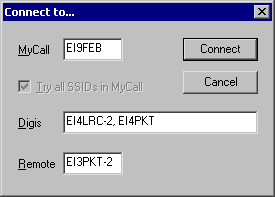Packet Radio
What is packet Radio?
Packet radio is a Radio Networking scheme actually designed by Radio Amateurs and derived from a scheme for networking data on the telephone network called X.25. Hence the protocol is called AX.25. As I write it must be getting close to 30 years old! Unlike other pre-DSP age modes for data , such as CW, RTTY, Fax and Hellscriber it is designed to give an error free connection end to end.
-
Lost packets
The errors are correct by resending the "damaged" part of the message. To this end a message is broken up and sent as chunks or packets that must be acknowledged as correct. This is quite unlike CW, RTTY and Hellscriber which has no acknowledgement. Even today, modern phone fax is not error free, only confirmation of a link is made. HF and RF Fax systems do not acknowledge reception at all. Traditional SSTV is actually a variation of Fax and nothing really to do with "TV" or data transmission at all.
-
Single Frequency Store & Forward
This is a basic feature of Packet. It means a basic Packet Repeater (Digipeater) only needs a single frequency and can alternately listen (Receive) and transmit. Every packet has an address. Every Packet Station (called a network Node or Node) has a unique address (usually the call sign of the operator). To operate as a "Digipeater" a node simply stores each packet, and if not addressed to the node simply retransmits them.
-
Collision Detection
Imagine four radio operators on the same frequency. You first listen to see if the channel is "clear". If it is you can put out a call. But if someone else does the same, you might do it at the same time! This is called a Collision. The Packet Radio protocol has a mechanism to detect if this might have occured and then retries a nearly random time later. Additionally, each node (radio station) will transmit a maximum number of packets and then listen for not just packet acknowlegments but other stations. (Lets give a pause to see is anyone else on frequency!). This is all automatic.
Real Life is bit more complicated. Later we will consider the problem of a node in a group which can only be "heard" by one neighbour. This is called the Hidden Transmitter Syndrome. It can cause the data rate of the "network" to drop dramatically as unexpected "collisions" and packet resending occurs. Later versions of AX.25 dedicated Digipeater software have special mechanisims to reduce this effect by creating a the concept of a master node (Digirepeater) and slave nodes (packet nodes with repeating turned off). To avoid degrading the network speed you should have "Digipeating" or "Repeater mode" turned off on a normal user station. Only dedicated "repeater" sites should "digirepeat".
-
Connecting
You can "lurk" or "listen only" to packet traffic without connecting. This will work for picking up "node list" broadcasts, APRS broadcast data or DX Cluster information. Anything "interactive" or involving transmission with a user node needs a "Connection". There are three kinds of connection:
-
Traditional Connect. You use the "Connect" command of your packet software and the call sign of the remote node. This can include a list of "digipeaters" to "traverse" to get to the destination. If it is not a direct connection you may wait a while with no reponse as the "connect" command is passed node by node to the destination and acknowleged on each hop. Each node to node connection is called a "hop" when you don't connect directly. You must know the route to the destination. Multihop connections can be made node by node rather than all at one command.

-
TCP/IP Datagram. No commands are needed at all. The "connections" are not explicitly made. The non-packet TCP/IP application simply sends and receives data using a "IP over AX.25" Network Interface Controller" (NIC). This need not be a real network card, though it could be, but simply software. The Packet protocol broadcasts special packets to establish if the destination exists, which must be acknowledged. On a multihop link lost packets might only be resent on the hop it was lost on, assuming reasonable Digirepeater Node SW. In theory if a packet network has had "routing tables" configured on the repeaters you need not know how to get to the destination (just like the Internet). Often the System Operators (sysops) or Repeater Keepers must manually configure the route tables. Internet routers are "automatic". This is possible for TCP/IP over AX.25, but don't expect it in Ireland, or most other Radio AX.25 networks.
-
TCP/IP Virtual Circuit. This is not at all common. MixW packet software can only do Datagram. not virtual Circuit TCP/IP. The X1J4 ROMS in Packet Repeaters (Digipeater) can do this. As indeed can some implementations of Linux AX.25 Generally a major disadvantage is that any lost packets must be resent over the whole network, all the hops! The advantage is that if there are no errors, the Virtual Circuit is faster than datagrams. It is less reliable. The connections are explictly made for each node as in (1).